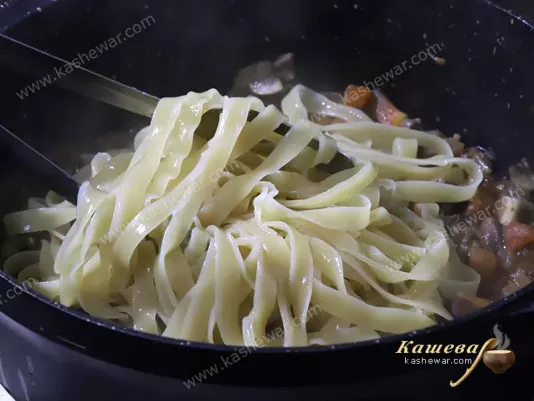Fettuccine with Giblets
Fettuccine with Giblets – a wonderful recipe for lunch or even dinner, it is prepared very easily and quickly.

Fettuccine is one of those pastas where small details decide everything. Over the years of cooking, I’ve learned that the quality of flour, dough density, and kneading time all affect the final texture. This ribbon-shaped pasta absorbs sauces beautifully but does not forgive carelessness during boiling. Dough that’s too soft tears, while unsalted water makes the flavor flat. When I work with fettuccine, I always aim for balance: not to overdry when drying, not to overcook, not to let it cool before combining with sauce. In this seemingly simple ingredient lies a whole science of temperature, moisture, and timing. That’s why fettuccine deserves as much respect as any other pasta and rewards with incredible tenderness.
When I choose fettuccine, I first look at the ingredients: only durum wheat flour and water. Over years of cooking, I’ve learned to recognize good pasta by sight – its surface should be matte, not smooth, as that texture holds sauce better. Among factory-made options, I prefer those dried slowly at low temperatures since they retain the grain’s flavor. Sometimes, I make fresh pasta myself when I have good eggs and flour, as homemade fettuccine yields a softer texture. Even ready-made pasta can be judged by aroma: there should be no smell of starch or moisture. If I notice broken ribbons or a brittle texture, it’s a sign of overdrying. For storage, I use a glass jar with a lid – fettuccine quickly absorbs odors and moisture, so airtightness is crucial. I always emphasize: there’s no universal option because each producer has their own balance of thickness, color, and density. With experience comes understanding of which texture suits each sauce – softer ones for creamy sauces, firmer for tomato-based. This stage determines the overall success of the dish.
Before setting the pot on the stove, I always check the ratio of water to pasta: at least one liter per hundred grams. This prevents fettuccine from sticking and ensures even cooking. I salt the water generously – it should taste like the sea, otherwise the pasta will be bland. If I’m using fresh ribbons, I gently shake off excess flour to avoid cloudy water. I never add oil while boiling – it’s a mistake that prevents the sauce from binding later. After boiling, it’s important to drain quickly and not rinse if serving immediately, since the starch on the surface helps the sauce adhere. If I need to delay serving, I drizzle a few drops of oil and cover to prevent drying. Another key point is precise time control. Even an extra twenty seconds can ruin the texture. I always test one ribbon for elasticity: if there’s slight resistance inside, it’s done. That way, it keeps its shape and doesn’t turn mushy in the sauce.
The most common mistake is neglecting the temperature of water and cookware. If fettuccine is dropped into water that’s not fully boiling, it softens unevenly. In my practice, I always wait for a rolling boil, then reduce the heat to a steady medium. When the water boils too vigorously, the pasta “hits” the pot walls and tears. It’s important that the water moves gently so the ribbons stay smooth. For doneness, I rely not only on timing but also on feel: I taste it when the color deepens and the center is no longer white. If I plan to cook fettuccine in a pan with sauce, I remove it slightly earlier – it finishes cooking together with the sauce. This method ensures perfect texture – the pasta absorbs flavor without losing firmness. Properly cooked fettuccine should be pleasantly elastic, not soft and limp. Once overcooked, it can’t be saved. I teach my students: it’s better to slightly undercook and let it finish in the sauce than wait another minute in the water.
Fettuccine naturally balances richness and delicacy, so it’s important to choose a sauce that complements rather than overwhelms its structure. I most often use creamy or cheesy bases – they coat the ribbons evenly, creating a smooth finish. For lighter versions, I add sautéed vegetables or herbs, always finely chopped to maintain uniformity. If I plan a tomato sauce, I control the acidity: too much makes the pasta tough. In my experience, a small amount of starchy cooking water helps achieve the right consistency – the sauce becomes silky and clings to the fettuccine. The flavor profile comes from simple ingredients: butter, garlic, black pepper, and grated cheese. It’s important to add seasonings gradually – too many spices ruin the natural dough flavor. I always aim for harmony, where pasta isn’t just a carrier of sauce but an equal participant in taste. That’s when the dish gains depth that no other type of pasta can provide.
The most frequent mistake is incorrect proportions: too much pasta and too little water, resulting in sticking. I explain that the problem lies not with the producer but with the process. If fettuccine turns grayish after cooking, it means the water wasn’t clean enough or it was oversalted. A slippery surface results from rinsing, which I never do unless necessary. In my practice, I always taste before serving: if there’s bitterness, the sauce was likely overheated or made with burnt oil. Another common mistake is improper storage: when left uncovered, fettuccine absorbs moisture and becomes brittle. I recommend keeping leftovers in a dry, cool place in airtight packaging. Avoid metal containers, as they can alter the aroma. Quality control isn’t just about texture but also attention to detail: spice freshness, serving temperature, and water purity. Experience teaches that the best dishes are born when every step is treated with care. That’s why fettuccine always deserves attention and precision.